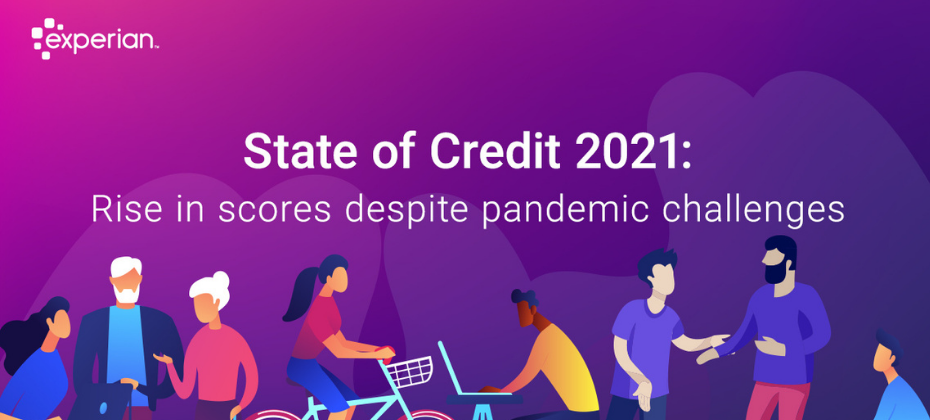Apply CIS Tag

Nearly 28 million American consumers are credit invisible, and another 21 million are unscorable.1 Without a credit report, lenders can’t verify their identity, making it hard for them to obtain mortgages, credit cards and other financial products and services. To top it off, these consumers are sometimes caught in cycles of predatory lending; they have trouble covering emergency expenses, are stuck with higher interest rates and must put down larger deposits. To further our mission of helping consumers gain access to fair and affordable credit, Experian recently launched Experian GOTM, a first-of-its-kind program aimed at helping credit invisibles take charge of their financial health. Supporting the underserved Experian Go makes it easy for credit invisibles and those with limited credit histories to establish, use and grow credit responsibly. After authenticating their identity, users will have their Experian credit report created and will receive educational guidance on improving their financial health, including adding bill payments (phone, utilities and streaming services) through Experian BoostTM. As of January 2022, U.S. consumers have raised their scores by over 87M total points with Boost.2 From there, they’ll receive personalized recommendations and can accept instant card offers. By leveraging Experian Go, disadvantaged consumers can quickly build credit and become scorable. Expanding your lending portfolio So, what does this mean for lenders? With the ability to increase their credit score (and access to financial literacy resources), thin-file consumers can more easily meet lending eligibility requirements. Applicants on the cusp of approval can move to higher score bands and qualify for better loan terms and conditions. The addition of expanded data can help you make a more accurate assessment of marginal consumers whose ability and willingness to pay aren’t wholly recognized by traditional data and scores. With a more holistic customer view, you can gain greater visibility and transparency around inquiry and payment behaviors to mitigate risk and improve profitability. Learn more Download white paper 1Data based on Oliver Wyman analysis using a random sample of consumers with Experian credit bureau records as of September 2020. Consumers are considered ‘credit invisible’ when they have no mainstream credit file at the credit bureaus and ‘unscorable’ when they have partial information in their mainstream credit file, but not enough to generate a conventional credit score. 2https://www.experian.com/consumer-products/score-boost.html

The payments landscape is rapidly evolving, and as businesses set their strategic agendas for the new year, it’s important to analyze and adapt to changing consumer payment behaviors. Here are a few payment trends to look out for: Consumer sentiment remains low while inflation hits 39-year high According to the University of Michigan’s latest consumer sentiment survey, sentiment rose to 70.4 in December 2021 from 67.4 in November. While this was a slight improvement from the 10-year low logged in November, the figure was roughly in line with the average reading of the past four months (70.6). Additionally, consumer prices increased 6.8% over the past year, the highest in nearly 40 years. When asked whether inflation or unemployment was the more serious problem facing the nation, 76% of survey respondents selected inflation while 21% selected unemployment. Rising prices and the uncertainty surrounding the Delta and Omicron variants may cause consumers to remain pessimistic about their personal financial progress and delay large purchases. Payment preferences vary by age and purchase type According to a recent Mintel report, credit cards are the most preferred method of payment among U.S. adults. Despite the overall preference for credit cards, attitudes toward this payment option differ based on consumer age. Credit card preference skews strongly toward older consumers, with 46% of Baby Boomers opting to use credit cards for most of their purchases and 72% of the World War II generation preferring credit cards to any other payment type. Conversely, younger generations are turning to cash, debit cards and digital payment alternatives for most of their purchases. This difference can be explained by younger consumers’ fear of debt and lack of credit education. While older consumers may feel more comfortable and capable of paying off their credit card bill each month, most Gen Z consumers are not creditworthy enough to own a credit card or are afraid of falling behind on their monthly payments. Though Gen Z’s low ownership rate may seem concerning to credit card issuers, there’s an enormous opportunity for them to reach and engage this younger cohort. By educating younger consumers about their products and the importance of building credit, credit card issuers can build lasting customer relationships and maintain their standing in the payments hierarchy. Payment preferences also vary by purchase type. Consumers mostly use debit cards and credit cards for in-store purchases, while direct payments from bank accounts are used to pay off recurring bills. Despite these preferences for card and online payments, cash remains a popular secondary payment method across age demographics. Older consumers use cash to make small, personal transactions, while younger consumers are more likely to use cash or debit cards for large purchases. Digital payment popularity continues to soar From 2019 to 2020, peer-to-peer payment (P2P) services, like Venmo, Zelle and Cash App, saw usage increases of 2 to 3 percentage points. In 2021, that year-over-year increase jumped to 8, 9 and 7 percentage points respectively. This jump indicates that while consumers may have been reluctant to adjust their payment behaviors at the beginning of the pandemic, ongoing social distancing measures forced them to adapt to a new reality, leading to the widespread adoption of digital payment methods. As consumers continue to embrace P2P services, traditional payment powerhouses must pivot their strategies to capitalize on this trend and remain competitive in today’s payments landscape. To keep up with the latest consumer and economic trends, register for our upcoming Monthly Credit and Economic Trends webinar.

Credit plays a vital role in the lives of consumers and helps them meet important milestones – like getting a car and buying their own home. Unfortunately, not every creditworthy individual has equal access to financial services. In fact, 28 million adult Americans are credit invisible and another 21 million are considered unscorable.1 By leveraging expanded data sources, you can gain a more complete view of creditworthiness, make better decisions and empower consumers to more easily access financial opportunities. The state of credit access Credit is part of your financial power and helps you get the things you need. So, why are certain consumers excluded from the credit economy? There’s a host of reasons. They might have limited or no credit history, have dated or negative information within their credit file or be part of a historically disadvantaged group. For example, almost 30% of consumers in low-income neighborhoods are credit invisible and African and Hispanic Americans are less likely than White Americans to have access to mainstream financial services.2 By gaining further insight into consumer risk, you can facilitate first and second chances for borrowers who are increasingly being shut out of traditional credit offerings. Greater data, greater insights, greater growth Expanding access to credit benefits consumers and lenders alike. With a bigger pool of qualified applicants, you can grow your portfolio and help your community. The trick is doing so while continuing to mitigate risk – enter expanded data. Expanded data includes non-credit payments, demand deposit account (DDA) transactions, professional certifications, and foreign credit history, among other things. Using these data sources can drive greater visibility and transparency around inquiry and payment behaviors, enrich decisions across the entire customer lifecycle and allow lenders to better meet the financial needs of their current and future customers. Read our latest white paper for more insight into the vital role credit plays within our society and how you can increase financial access and opportunities in the communities you serve. Download now 1Data based on Oliver Wyman analysis using a random sample of consumers with Experian credit bureau records as of September 2020. Consumers are considered ‘credit invisible’ when they have no mainstream credit file at the credit bureaus and ‘unscorable’ when they have partial information in their mainstream credit file, but not enough to generate a conventional credit score. 2Credit Invisibles, The CFPB Office of Research, May 2015.

Who said that direct mail was dead? Though consumers have flooded to digital channels since the onset of the pandemic, with 55% now having a higher expectation of their customer experience, traditional methods shouldn't be cast aside. On the other hand, sending printed mail without adapting to consumer demands may leave recipients disengaged and less likely to act. So, where does that leave marketers? How can businesses create a balance between traditional and digital credit marketing? Before diving into that discussion, it’s important to note that direct mail is still effective and when done right, can help businesses win the hearts and wallets of today’s consumers. According to the U.S. Postal Service’s (USPS) Certified Direct Mail Professional (CDMP) program, 79% of households say they read their daily mail, while 70% of recipients are curious to find out what’s in their mailbox. So, how can credit card marketers capitalize on these trends to generate higher response rates and returns from their direct mail campaigns? It’s simple – businesses must weave interactive elements and technology into their direct mail pieces to make them more effective and engaging. Here’s how credit card issuers are leveraging technology to level up their direct mail campaigns: QR codes QR codes, which allow consumers to read restaurant menus and make touchless payments with their mobile devices, have become a global sensation, with the number of interactions having grown 94% between 2018-2020. More recently, credit card marketers have included interactive QR codes into their direct mail pieces, allowing recipients to learn more about the offer, download their mobile app or quickly apply for a credit card. A few brands took it a step further by matching their QR codes with the colors of their logos to add more brand recognition and personalization. Voice Activated Call to Action (VACTA) According to Mintel, over 25% of U.S. adults own at least one smart speaker. To capitalize on this trend, many credit card issuers have included a Voice Activated Call to Action (VACTA) in their direct mail pieces. A VACTA allows recipients to respond to direct mail offers verbally by using their Amazon Alexa or Google Assistant device. Instead of reaching for their smartphones or laptops, consumers can call out to their smart speaker with the offer code. This low-effort, hands-free method is a quick and convenient way for consumers to engage with businesses as it enables them to respond to offers even when they are performing other tasks. Once their smart speaker receives the code, a link is then sent to the consumer’s phone so that they can examine the offer at any time. Giving consumers more flexibility enhances their experience and increases the chances of them responding to future offers. Additionally, including a VACTA in direct mail pieces allows marketers to manage, track and optimize their marketing campaigns in real-time. Because VACTAs make offers immediately redeemable, businesses can easily measure the performance and effectiveness of each direct mail piece. Informed Delivery emails What better way to build anticipation and excitement for direct mail offers than to give consumers a sneak peek of what’s to come? USPS’s Informed Delivery is a service that allows consumers to digitally preview their direct mail before it arrives in their physical mailbox. Until the physical mail piece is delivered, consumers can look at what the mailing might reveal or offer to them through email, an online dashboard or a mobile app. The best part? Informed Delivery emails meet today’s consumer expectations for convenient digital experiences as they are available to view them anytime, anywhere. Currently, one in five households has an Informed Delivery participant. What’s more, the average open rate for an Informed Delivery email is nearly 70%. By incorporating Informed Delivery into direct mail campaigns, businesses can generate additional impressions, improve customer engagement and drive more conversions. Doing direct mail, the right way Direct mail isn’t outdated, antique or ineffective – it has evolved and adapted to meet the expectations of today’s consumers. The use of QR codes, VACTA and USPS Informed Delivery, are just a few examples of how credit card marketers are leveraging digital enhancements to improve the success of their direct mail campaigns. While it’s clear that direct mail is still an effective way to reach consumers, businesses should not overlook the power of digital marketing. Expectations for seamless and connected digital experiences are higher than ever, making it crucial for businesses to develop strong digital marketing strategies. By engaging with consumers in the way that works best for them, with the right messages at the right time, you can drive more opportunities, reduce costs and deliver exceptional customer experiences. Learn more Download white paper

Experian was recently named a global fintech leader in the Center for Financial Professionals (CeFPro) Fintech Leaders 2022 report, ranking among the report’s top companies within the Credit Risk and Fraud Prevention categories, and in the top 15 Overall Ecosystem Rankings, rising five places from 2021. This award comes at a time where fraud and identity management services are of utmost importance given the rise of digital channels and activity; and as risk management strategies continue to be a priority – especially in times of economic volatility. “This recognition as a fintech leader by industry peers is a testament to how Experian partners with businesses and consumers to enable fintechs with innovative solutions and insights to mitigate credit risk and make better decisions,” said Jon Bailey, Vice President of Fintech at Experian. “Despite times of rapid change, Experian has been and remains committed to focusing on helping our clients with a wide range of challenges by providing valuable solutions. It’s great to see our continued efforts and investments driving positive impact. We will continue to invest and innovate to enable our clients for growth and create opportunities to support their customer-first missions.” Over the past year, Experian has placed bets on helping open-up credit to underserved communities, adapting to changing consumer expectations, addressing the growing threat from fraud, and becoming a more agile technology provider in an ever-changing market while helping clients mitigate credit risk. To learn more about Experian’s solutions that power fintechs, visit our fintech solutions page here. Click here for the full press release and to read more about the award.

Credit scores play a massive role in a consumer’s financial life as they help determine an individual’s creditworthiness. While 62% of consumers are interested in improving their credit scores, a troublingly high percentage are unsure of where to start. What’s more, one in four Americans have no idea how credit scores are even determined. This knowledge gap presents an opportunity for financial institutions to help consumers increase their credit understanding and establish lasting relationships. Some of the benefits of providing credit education to consumers include: Consumer trust and loyalty Today’s consumers are looking for guidance and support on all things credit. Helping consumers navigate their credit reports, improve their credit scores and explore the impacts of various scenarios are all opportunities for financial institutions to meet this demand and foster loyalty. With the knowledge and tools needed to make confident and responsible financial decisions, consumers will continue to trust and look toward the same financial institutions for credit guidance as they navigate their financial journeys. Credit education is especially valuable to younger consumers. As rookies to the credit game, many Gen Zers may find credit to be mysterious, complex and difficult to grasp. Despite these feelings, Gen Zers have shown considerable interest in becoming financially literate. By continuously providing Gen Z consumers with reliable and accessible credit education early on, financial institutions can grow to become their valuable partner, educator and mentor for life. More cross-sell opportunities The more educational resources financial institutions provide their consumers, the more likely they are to pay their credit card bills on time, take out loans and mortgages they can meet and purchase within their buying power, making them prime candidates to approach for additional credit offerings. According to studies conducted by Visa Performance Solutions, consumers respond more to credit offers from institutions they currently have a relationship with than those they don’t. By providing credit education and relevant offers to existing customers, financial institutions can improve satisfaction while increasing their revenue. Enhances brand reputation While credit education allows financial institutions to strengthen their relationships with existing clients, it also gives them an opportunity to expand and acquire new ones. When consumers feel valued and cared for, they are more likely to recommend a business’s products and services to someone else. The more consumers see how much a financial institution invests in their customers’ financial well-being, the more likely they are to convert themselves. Ready to get started? Providing value to consumers is no longer just about offering great products and services; it’s about helping them understand the basics and importance of credit so that achieving their financial goals comes easily. To learn more about how credit education can help deepen customer relationships and drive business growth, visit our Experian Partners Solutions page. Learn more

Generation Z has money on their minds, and as their appetite for personal finance grows, financial institutions better be ready. Accounting for 40% of all U.S. consumers, Gen Z is comprised of digital natives with little to no memory of the world as it existed before smartphones, social media and the internet. Aside from growing up in a tech-saturated world, Gen Zers are also socially conscious and determined to take control of their financial futures. According to Credit Union Times, Gen Zers wield a purchasing power of more than $143 billion, which is projected to increase by more than 70% in the next five years. What do these insights mean for financial institutions? As the newest and soon-to-be largest cohort of consumers, Gen Zers represent an enormous opportunity for growth. While establishing a relationship with Gen Z now is key to creating lifelong customers, the same approaches used to capture previous generations may not be as effective with this younger cohort. To successfully reach and acquire Gen Z consumers, financial institutions must recognize their unique needs, preferences and experiences. Here are some key trends and preferences to consider: They live and breathe social media. According to Mintel, 99% of Gen Z adults and teens are active social media users. Despite this percentage of Gen Zers on social media, credit card issuers spent 94% of their media budget on direct mail from January 2019 to May 2021. This highlights the need for financial institutions to recognize social media as a powerful and necessary marketing vehicle. As a fast-growing consumer group with massive spending power, Gen Z makes for valuable customers, but are being missed by current marketing strategies. While direct mail is popular among millennials, financial institutions must recognize Gen Z’s preference for social media and pivot themselves to effectively reach them. By leveraging both social media and direct mail, financial institutions can dramatically increase their reach and acquire a wider pool of consumers. They want to be financially literate. Concepts like budgeting, investing and credit building can seem daunting to Gen Zers, especially if they lack the proper guidance and resources to get started. According to a NerdWallet survey, 41% of Gen Zers feel anxious about their personal finances, while 40% feel nervous and confused. To add onto their worries, older Gen Z members may have witnessed their parents struggle financially during the Great Recession or have seen millennials burdened with student loan debt. For fear of facing the same challenges as their predecessors, Gen Zers have shown great interest in taking control of their financial lives and becoming financially literate. In response to this desire for financial education, many banks and credit card issuers have taken an educational approach in their marketing by using infographics and ‘how-to’ guides to teach Gen Z about the basics of personal finance. Offering educational resources not only gives Gen Zers the confidence to make financial decisions, but it gives financial institutions the opportunity to build an early connection with this consumer group. Many banks and credit card issuers are also positioning themselves as companies Gen Zers can “grow with.” By not limiting their products to a specific life stage, these financial institutions seek to grow alongside the consumer so that they remain loyal customers even when their needs and lifestyles change. They care about what brands stand for. According to Mintel Trend Buydeology, Gen Z consumers are passionate about the causes close to their hearts and are more likely than other generation to pay a higher price for brands that support the causes they care about. With this in mind, financial institutions must prove they are authentic, socially responsible and committed to serving their communities. To resonate with Gen Z consumers and align with their preferences, financial institutions should educate themselves about social issues, take part in meaningful discussions both on and offline, and develop innovative strategies to drive real impact and change. Ready to win over Gen Z? Financial institutions have a massive opportunity to build lasting relationships with Gen Z consumers and having a pulse on what this fast-growing segment wants is a must. To learn more, check out our efforts to help marginalized and underserved communities or join our upcoming webinar on November 3, 2021. Learn more Register for webinar

Experian recently announced that it has made the IDC 2021 Fintech Rankings Top 100, highlighting the best global providers of financial technology. Experian is ranked number 11, rising 33 places from its 2020 ranking. IDC also refers to Experian as a ‘rising star.’ The robust data assets of Experian, combined with best-in-class modeling, decisioning and technology are powering new and innovative solutions. Experian has invested heavily in new technologies and infrastructures to deliver the freshest insights at the right time, to make the best decision. For example, Experian's Ascend Intelligence Services™ provides data, analytics, strategy, and performance monitoring, delivered on a modern-tech AI platform. With the investment in Ascend Intelligence Services, Experian has been able to streamline the delivery speed of analytical solutions to clients, improve decision automation rates and increase approval rates, in some cases by double digits. “Recognition in the top 20 of IDC FinTech Rankings demonstrates Experian’s commitment to the success of its financial clients,” said Marc DeCastro, research director at IDC Financial Insights. “We congratulate Experian for being ranked 11th in the 2021 IDC FinTech Rankings Top 100 list.” View the IDC Fintech Rankings list in its entirety here. Focus on Data, Advanced Analytics and Decisioning Creates Winning Strategy for Experian Experian’s focus on data, advanced analytics and decisioning has continued to gain recognition from various notable programs that acknowledge Fintech industry leaders and breakthrough technologies worldwide. Beyond the IDC Fintech Rankings Top 100, Experian won honors from the 2021 FinTech Breakthrough Awards, the 2021 CIO 100 Awards and was most recently shortlisted in the CeFPro Global Fintech Leaders List for 2022 in the categories of advanced analytics, anti-fraud, credit risk and core banking/back-end system technologies. “At Experian, we are committed to supporting the Fintech community. It’s great to see our continued efforts and investments driving positive impacts for our clients and their consumers. We will continue to invest and innovate to help our clients solve problems, create opportunities and support their customer-first missions,” said Jon Bailey, Vice President for Fintech at Experian. Learn more about how Experian can help advance your business goals with our Fintech Solutions and Ascend Intelligence Services. Explore fintech solutions Learn more about AIS

Financial inclusion is a challenge, that, while not new, has become ever more apparent over the last year. The inequities and inequalities in our society, exasperated by the COVID-19 pandemic, which disproportionately affected underserved populations, have amplified the challenge lenders and others in the financial services industry face in fostering financial inclusion. As a result, there is an increased focus and importance on diversity, equity and inclusion (DEI) and having the ability to assess creditworthiness of overlooked and ‘invisible’ consumers. In a recent webinar, we sat down with Sarah Davies, Head of Data Analytics at Nova Credit, and a panel of Experian experts including Wil Lewis, Chief Diversity, Equity and Inclusion Officer, Alpa Lally, Vice President of Product Management, and Greg Wright, Product Chief Officer, to explore the topic of DEI, what best practices exist to break down financial inclusion barriers and move financial access forward for all, and real-takeaway strategies and capabilities designed for fintechs and other financial institutions to leverage for lending deeper. Below are a few key perspectives from our speakers: What barriers to access are there for credit across different groups of people? [WL]: There are many barriers to financial inclusion, especially for underserved communities. The first of which is lack of awareness and lack of education about credit and how it impacts financial access – from obtaining loans, buying a first home, a new car and more. Not every American has someone in their life to teach and provide coaching on credit responsibility and how to be financially literate. [AL]: Historically, credit, wealth and health inequalities have all contributed to financial disparities, and as a result, have created an underrepresentation of marginalized communities in the current credit ecosystem. That’s compounded by today’s ecosystem where consumer underwriting favors those with established thick-file credit histories with minimal delinquencies, particularly in the last 24 months. So, all things being equal, additional points distributed to elevate scores are given to consumers that are maintaining low revolving debt. This poses credit barriers for those starting out new to credit, or even to immigrants coming into a new country who don’t have an established credit history. What role could the credit industry play in healing the financial disparities created by the COVID-19 pandemic? [WL]: Our opportunity lies in meeting consumers where they are today. COVID-19 has spotlighted economic and social disparities in a way it hasn’t been done before. At the same time, it illustrated how the inability of some groups to access financial services requires meaningful solutions, quickly. Historically, organizations have been known to look at this in a traditional way: meaning “we are the organization, consumers come to us and we can tell you what you can and can’t do.” We need to shift our focus to how we can provide consumers with tools, technology and machine learning (ML) that are available to empower them. [SD]: One of the lessons we’ve learned from COVID, is that we need to be able to get to the marketplace fast in order to respond to the economic conditions. Fintechs have been very effective at this and it has shown through the approach they’ve taken towards immediacy in identifying, developing and distributing solutions. With consumers in a stressed position, it’s incumbent upon us, as the industry, to deliver consumer-centric options and opportunities in an efficient manner rather than having our consumers sit around waiting for them. Are there solutions to help ensure we are lending deeper and serving thin-filed consumers? [AL]: At its core, data – not limited to only traditional credit data – that can be decisioned on, can help enrich financial inclusion. Alternative data, or expanded FCRA data, means that the data is displayable, disputable and correctable by the consumer. We recognize that traditional credit is still an effective way to assess a consumer’s credit worthiness. However, expanded FCRA data includes data points from rental, video streaming, all other industry sectors to help provide a 360 view of the consumer with additional insights - whether you are a thick-file consumer, thin-file consumer, or credit invisible. Through these different various data assets paired with advanced analytics and ML, we now have a mechanism to make sure consumers go from credit invisible to visible – and scorable. Leveraging Experian Boost and Experian Lift scores can do just that. [SD]: Expanded FCRA data is powerful and vital for helping the consumer. In addition, we are now in a place where the consumer can take on the responsibility and accountability for giving permission to include their data in the credit score. You’re putting the consumers in the driver seat, and with that, we are dissolving the psychological barriers that consumers may have had previously around their credit score being out of their control. As a player in the financial services space, we can put out as much data as we want, but it’s about engaging the consumer, sharing with them how it’s safe to share their data, and what the benefits of doing so are. Are there tangible and intangible benefits of DEI that companies can realize when they have formal DEI programs in place? [WL]: Often times, when we think of lending, we talk about it from the standpoint of our business – ‘what are we doing for our customers, how are we helping consumers who are going to a institution for a loan.’ What we typically forget about is our own backyard. Every organization has employees who are at different points in their credit journey. How often do we talk directly to our employees and give them tools and details that may help them, their family member, or neighbor? As I think about DEI, it’s about involving folks inside your company to continue moving financial inclusion forward. As for an intangible benefit, when doing work in DEI and driving impact, you’re also reducing negative reputational risk. Reputable brands are invaluable, as you begin to make and show an impact, consumers begin to trust you. [AL]: Brand and reputation is huge in today’s world. We are starting to see a shift in consumers selecting certain institutions to work with, not just because of the services provided, but because it’s based on the brand and what they stand for. You as an institution are doing financial inclusion and you’re living up to it. You are truly embarking internally and externally on this initiative and it adds weights on the products and solutions that you sell. For consumers, that may be very important. What does the future look like relative to financial inclusion? [WL]: It’s a world where all of us play a role in - no matter where you are in the organization. It’s all of our jobs and responsibility to talk about it to our fellow neighbor, consumer, and direct them to tools that will help them. [SD]: We no longer need to justify why financial inclusion is necessary. We’ve got all the data we need. Tools and mechanisms for organizations and consumers are almost universally available. The go-forward view requires all ‘players’ within the space to aggressively embrace these tools and data and start sharing and applying them across all markets and verticals. There’s no longer a reason not to be able to underwrite somebody with a thin file or marginal set of data. We have everything in place at this point. [AL]: It’s all our jobs. I think we have to put a lot of importance on our younger leaders and colleagues to carry our initiatives forward, so we are truly inclusive. We have just started taking the initial steps and we’ve made good progress, but we need to continue to make progress. In the future, I hope to see all that are younger take this forward and drive financial inclusion for all across the spectrum. Watch the full session to hear more of the engaging and timely discussion. Access the recording To learn more about how Experian is committed to advancing financial inclusion, please visit Experian’s Inclusion Forward resources page. For Fintechs looking to partner with Experian on marketplace lending solutions, explore our solutions here.

Artificial intelligence is here to stay, and businesses who are adopting the newest AI technology are ahead of the game. From targeting the right prospects to designing effective collections efforts, AI-driven strategies across the entire customer lifecycle are no longer a nice to have - they are a must. Many organizations are late to the game of AI and/or are spending too much time and money designing and redesigning models and deploying them over weeks and months. By the time these models are deployed, markets may have already shifted again, forcing strategy teams to go back to the drawing board. And if these models and strategies are not being continuously monitored, they can become less effective over time and lead to missed opportunities and lost revenue. By implementing artificial intelligence in predictive modeling and strategy optimization, financial institutions and lenders can design and deploy their decisioning strategies faster than ever before and make incremental changes on the fly to adapt to evolving market trends. While most organizations say they want to incorporate artificial intelligence and machine learning into their business strategy, many do not know where to start. Targeting, portfolio management, and collections are some of the top use cases for AI/ML strategy initiatives. Targeting One way businesses are using AI-driven modeling is for targeting the audiences that will most likely meet their credit criteria and respond to their offers. Financial institutions need to have the right data to inform a decisioning strategy that recognizes credit criteria, can respond immediately when prospects meet that criteria and can be adjusted quickly when those factors change. AI-driven response models and optimized decision strategies perform these functions seamlessly, giving businesses the advantage of targeting the right prospects at the right time. Credit portfolio management Risk models optimized with artificial intelligence and machine learning, built on comprehensive data sets, are being used by credit lenders to acquire new revenue and set appropriate balance limits. Strategies built around AI-driven risk models enable businesses to send new offers and cross-sell offers to current customers, while appropriately setting initial credit limits and managing limits over time for increased wallet share and reduced risk. Collections AI- and ML-driven analytics models are also optimizing collections strategies to improve recovery rates. Employing AI-powered balance and response models, credit lenders can make smarter collections decisions based on the most predictive and accurate information available. For lending businesses who are already tight on resources, or those whose IT teams cannot meet the demand of quickly adapting to ever-changing market conditions and decisioning criteria, a managed service for AI-powered models and strategy design might be the best option. Managed service teams work closely with businesses to determine specific use cases, develop models to meet those use cases, deploy models quickly, and monitor models to ensure they keep producing and predicting optimally. Experian offers Ascend Intelligence Services, the only managed service solution to provide data, analytics, strategy and performance monitoring. Experian’s data scientists provide expert guidance as they collaborate with businesses in developing and deploying models and strategies around targeting, acquisitions, limit-setting, and collections. Once those strategies are deployed, Experian continually monitors model health to ensure scores are still predictive and presents challenger models so credit lenders can always have the most accurate decisioning models for their business. Ascend Intelligence Services provides an online dashboard for easy visibility, documentation for regulatory compliance, and cloud capabilities to deliver scores and decisions in real-time. Experian’s Ascend Intelligence Services makes getting into the AI game easy. Start realizing the power of data and AI-driven analytics models by using our ROI calculator below: initIframe('611ea3adb1ab9f5149cf694e'); For more information about Ascend Intelligence Services, visit our webpage or join our upcoming webinar on October 21, 2021. Learn more Register for webinar

Despite an unprecedented 18 months since the pandemic was in full force and many Americans were sent home, financial wellness continues to be on the up and up. Consumers continue to manage credit well and the average credit score climbed seven points since 2020 to 695, the highest point in more than 13 years. In Experian’s 12th annual State of Credit report, the headlines are hopeful regarding how Americans are managing personal finances in the face of the pandemic. The report provides a comprehensive look at the credit performance of consumers across America by highlighting consumer credit scores and borrowing behaviors. This year’s report features data from 2019 pre-pandemic, the 2020 pandemic year, and the start of 2021. “The findings from this year’s report show something I’ve always believed: Americans are resilient, for the most part they make smart decisions in the face of adversity and they are agile in adjusting their financial habits when the environment or circumstances change,” said Alex Lintner, President, Experian Consumer Information Services. Highlights of Experian’s State of Credit report: 2021 State of Credit Report 2019 2020 2021 Average VantageScore® credit score [1] 682 688 695 Median VantageScore® credit score 687 697 707 Average number of credit cards 3.0 3.0 3.0 Average credit card balance $6,494 $5,897 $5,525 Average revolving utilization rate 30% 26% 25% Average number of retail credit cards 2.50 2.42 2.33 Average retail credit card balance $1,930 $2,044 $1,887 Average nonmortgage debt $25,057 $25,483 $25,112 Average mortgage debt $210,263 $215,655 $229,242 Average auto loan or lease $19,034 $19,462 $20,505 Average 30–59 days past due delinquency rates 3.8% 2.4% 2.3% Average 60–89 days past due delinquency rates 1.9% 1.3% 1.0% Average 90–180 days past due delinquency rates 6.6% 3.8% 2.5% We asked Joseph Mayans, Principal Economist at Advantage Economics, LLC, for his reactions to the findings: “The State of Credit Report captures the three central themes of the pandemic. First, it shows the overwhelming success of the fiscal support packages. By far, the most striking example of this is the broad based and significant decline in delinquencies during a time when millions of people were out of work. Second, the report showcases the resiliency of American households. People used their stimulus dollars to stay on top of their bills and pay down debt, which boosted average credit scores across all generations. And third, it highlights the unique behavioral shifts brought on by the pandemic. We can see these changes in the rise of housing and auto debt as people bought larger homes and sought to drive rather than ride public transportation.” Generational Trends As indicated in the findings, consumers across all generations except Gen Z saw decreased utilization rates and decreased credit card balances year over year. Consumers are also missing fewer payments with notable improvements seen among the youngest consumers. Mortgage debt was up across every generation, which may correlate with the record low interest rates on mortgages, refinances and moves. According to the CBRE, “the pandemic accelerated several long-standing American migration patterns” as evidenced by more than 15.9 million people filing change-of-address requests with the United States Postal Service. Compared with 2019, 2020 change-of-address requests show a 4% increase in total movers, 2% increase in permanent movers and 27% increase in temporary movers, according to a study by MyMove. Mayans also made note of the mortgage trends. “It’s becoming clearer that millennials are stepping into the homebuying phase in a big way. Once thought to be the generation of apartments and urban revival, many older millennials are now buying homes and moving to the suburbs much like their parents before them,” Mayans said. “This will have significant implications for the post-pandemic world, especially as work from home becomes more prevalent.” State Trends The states with the highest and lowest average credit score remained unchanged from last year with the highest average score of 726 held by Minnesota and an average score of 666 held by Mississippi. New Jersey had the highest number of credit cards and retail cards at 3.37 and 2.54 respectively, and Alaska had the highest credit card debt at $7,089 (U.S. average is $5,525) and Texas had the highest retail debt at $2,248 (U.S. average is $1,888). What Lies Ahead Some have argued that the past year of the pandemic and quarantine forced a lot of time for reflection. The continued positive trends of consumer behavior seem to indicate some of that effort was put toward better financial health practices. That said, like any sourdough bread recipe or DIY home glow-up, there’s always more to learn and opportunities to seize when it comes to financial health. “We are committed to working with lenders and the industry to help consumers gain access to credit, driving broader financial inclusion, while also teaching consumers how to responsibly build and use credit responsibly,” Lintner said. In addition to the free weekly credit report at AnnualCreditReport.com, Experian also offers consumers free access to their credit report and ongoing credit monitoring at Experian.com. Additional credit education resources and tools Join Experian’s #creditchat hosted by @Experian on Twitter with financial experts every Wednesday at 3 p.m. Eastern time. Bilingual and Spanish speakers are also invited to join Experian’s monthly #ChatdeCredito hosted on Twitter at 3 p.m. Eastern time beginning September 16. Visit the Ask Experian blog for answers to common questions, advice and education about credit. Add positive telecom, utility and streaming service payments to your Experian credit report for an opportunity to improve your credit scores by visiting experian.com/boost[2] For additional resources, visit https://www.experian.com/consumereducation To see all the findings, download the 2021 State of Credit Report. Download the full report [1] VantageScore® is a registered trademark of VantageScore Solutions, LLC. VantageScore® credit score range is 300 to 850. [2] Results may vary. See Experian.com for details

The collections landscape is changing as a result of new and upcoming legislation and increased expectations from consumers. Because of this, businesses are looking to create more effective, consumer-focused collections processes while remaining within regulatory guidelines. Our latest tip sheet has insights that can help businesses and agencies optimize their collections efforts and remain compliant, including: Start with the best data Keep pace with changing regulations Focus on agility Pick the right partner Download the tip sheet to learn how to maximize your collections efforts while reducing costs, avoiding reputational damage and fines, and improving overall engagement. Download tip sheet

As last year’s high-volume mortgage environment wanes, lenders are shifting focus to address another set of challenges. Continued economic uncertainty lingers as consumers navigate towards recovery. As such, mortgage lenders have less clarity than normal to assess risk and measure performance in their servicing portfolios. On top of that, more lenders are struggling with customer retention than ever before, due to a historically low rate environment in 2020. These combined factors create a new set of challenges servicers will face in the coming months. We explore a few of these challenges below. An incomplete picture of risk The CARES Act accommodation reporting structure has made it challenging for servicing teams to fully understand the impact of forbearance in their portfolios. If looking only at a CARES Act accommodated borrower’s credit profile, there is no indication whether that consumer would otherwise be delinquent or headed towards default. In turn, lenders cannot model out risk based on this information alone. Borrowers’ financial situations can still change rapidly, and some are still struggling to regain their financial footing. Property data also plays a part in a holistic view of risk. Partly due to lack of housing inventory, home equity continues to rise in many areas of the country, yet there is still uncertainty around whether prices are overinflated, whether the market will correct itself and by how much, and the impact the foreclosure moratorium may have on one’s portfolio. And property dynamics continue to change due to consumer migration stemming from the onset of virtual or hybrid work environments, where homeowners are less bound geographically to a place of work. Being able to have insight into a holistic view of risk is critical to navigating the upcoming months in mortgage servicing. Low borrower retention 2020’s prevailing low-rate environment continues to persist well into 2021 creating a big challenge for mortgage servicers in terms of borrower retention. Borrowers continue to be incentivized to refinance, and in some instances multiple times, to capture the savings throughout the life of their mortgage. Every time a borrower refinances, the lender who’s servicing the loan risks losing the borrower to another lender. This portfolio runoff can create losses for the lender; high portfolio run off rates have shown to negatively impact portfolio performance and investor credibility while increasing marketing cost for new customer acquisition. In our Mortgage in 2021 webinar, we point to the sheer magnitude of this – at the end of 2020, a whopping 33% of first mortgages were less than a year old. Additionally, with the uptick in the number of fintech mortgage lenders and aggregation websites, it has become increasingly easy for consumers to shop for alternative options. Being able to predict the consumers likely to refinance can help servicers retain existing customers and reduce losses. Lack of operational efficiency Lenders and servicers had to increase the capacity of their systems, oftentimes at the turn of a dime, due to last year’s record-breaking origination volumes. This led to massive growing pains while simultaneously stress-testing a company’s systems and processes. As a result, the overall cost to produce a mortgage has risen. Borrower data hygiene poses a challenge for many servicers as well. There was a lot of movement in 2020 in terms of mergers and acquisitions which may also affect servicers’ operational efficiency. Marrying several disparate data points during such events can lead to borrower data inconsistencies and duplicates across loan origination systems. And as consumers come out of forbearance or deferral status, servicers are managing more calls to their inbound call centers, increasing the scope of the problem. Having tools to ensure data accuracy and correct consumer contact information can help reduce operating cost. Conclusion There certainly is a lot of pressure on servicers to optimize and be in a position to efficiently help homeowners in need as forbearance and foreclosure moratoriums end. But with the right data, insights and partners, mortgage servicers can navigate these challenges all while managing risk and enabling the business to grow safely. In our next blog, we highlight what forward-thinking lenders and servicers are focusing on now to navigate the upcoming months in mortgage servicing. Learn more

The Telephone Consumer Protection Act (TCPA), which regulates telemarketing calls, autodialed calls, prerecorded calls, text messages and unsolicited faxes, was originally passed in 1991. Since that time, there have been many rulings and updates that impact businesses’ ability to maintain TCPA compliance. Recent TCPA Changes On December 30, 2020, the Federal Communications Commission (FCC) updated a number of TCPA exemptions, adding call limits and opt-out requirements, and codifying exemptions for calls to residential lines. These changes, along with other industry changes, have added additional layers of complication to keeping compliant while still optimizing operations and the consumer experience. Maintaining TCPA Compliance Businesses who do not maintain TCPA compliance could be subject to a lawsuit and paying out damages, and potential hits to their reputation. With the right partner in place, businesses can maintain data hygiene and accuracy to increase right-party contact (and reduce wrong-party contact) to keep collections streamlined and improve the customer experience. Using the right technology in place, it’s easier to: Monitor and verify consumer contact information for a better customer experience while remaining compliant. Receive and monitor daily notifications about changes in phone ownership information. Maintain compliance with Regulation F by leveraging a complete and accurate database of consumer information. When searching for a partner, be sure to look for one who offers data scrubbing, phone type indicators, phone number scoring, phone number identity verification, ownership change monitoring, and who has direct access to phone carriers. To learn more about how the right technology can help your business maintain TCPA compliance, visit us or request a call. Learn more

Millions of consumers lack credit history and/or have difficulty obtaining credit from mainstream financial institutions. As a result, the use of expanded Fair Credit Reporting Act (FCRA) – or alternative – data has continued to gain popularity among lenders and financial intuitions to enrich decisions across the entire lending lifecycle to meet the financial needs of their consumers. Experian presented in a recent webinar hosted by AFSA, where Alpa Lally, Vice President of Product Management, and David Elmore, Automotive Solutions Consultant, had a chance to speak about the benefits of FCRA data, and ways lenders can leverage this data to ease access to credit for “invisible” and below prime consumers. Watch the full webinar, “FCRA Data: The Key to Unlocking Credit Universe” and learn more about: How expanded FCRA data is being used throughout the lending lifecycle The benefits of leveraging FCRA data including providing a more holistic view of a consumer’s credit profile and behavior beyond financial services, leading to smarter, more informed lending decisions The lift FCRA data can offer when augmented with traditional credit data This webinar is a part of AFSA’s partner webinar series. To learn more about FCRA data and explore related content, please visit our FCRA Alternative Credit Data Resources Page. Learn More About FCRA-Alternative Credit Data